
STAY IN THE BUNGALOW KNOW!!!
Sign up for our newsletter & receive our FREE E-book, 7 VITAL Things to Do Before You Hire a Contractor.
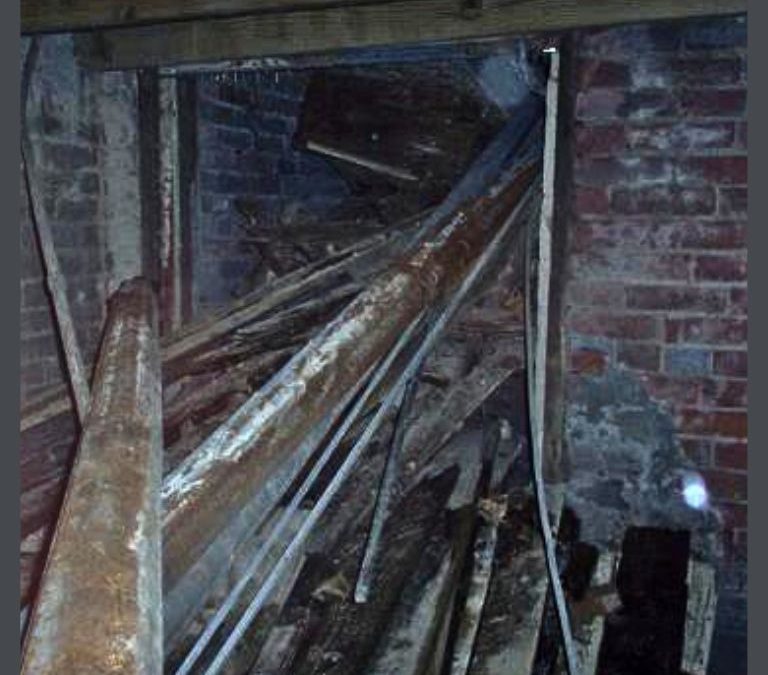

4 head Jos. O Colladay molding machine
This is post #3 in a series about how I got into restoration. At this point I was putting together the millwork shop.
In January of 2003, a whole barn full of machines came up for sale on eBay. I was interested in only one of these, an 1880’s Jos. O. Colladay 4 head molding machine. I knew that this type machine made all the straight moldings for houses in that era. It closely resembled the drawings in the 1880 Census Report.
I waited until the last 30 seconds of the auction to put in my high bid of $202.50. I won. It was located in Schuylkill Haven, PA, a bit over 800 miles from me. In those days, gas was cheap, and I could drive that far and back for a little over a hundred dollars. I immediately planned a trip to pick it up, and my wife agreed to go along.
In my efforts to retrieve this machine, my determination would outstrip my good sense not once, but twice.
 We set out on a cold January day, and when we got about 400 miles from home, it started to snow. By this time we were in the mountains of West Virginia. It was dark. My wife was taking a turn driving, when she looked over and told me she couldn’t steer. The road was getting really slick. We pressed on until we got past the Pennsylvania state line. The weather was not getting any better, so after seeing cars off the road way too frequently, my wife convinced me we needed to stop and go home. When I found out we were still hundreds of miles from our destination, and the machines were on the second floor of the barn, with no reasonable way down, I agreed to go home. This was lesson #3: winter is a terrible time to haul stuff long distances.
We set out on a cold January day, and when we got about 400 miles from home, it started to snow. By this time we were in the mountains of West Virginia. It was dark. My wife was taking a turn driving, when she looked over and told me she couldn’t steer. The road was getting really slick. We pressed on until we got past the Pennsylvania state line. The weather was not getting any better, so after seeing cars off the road way too frequently, my wife convinced me we needed to stop and go home. When I found out we were still hundreds of miles from our destination, and the machines were on the second floor of the barn, with no reasonable way down, I agreed to go home. This was lesson #3: winter is a terrible time to haul stuff long distances.
The seller recommended I talk to the person who bought all the rest of the machinery there. He happened to live in Missouri, and would have to drive by my house anyway. Even though I had sniped the molder out from under him, he was gracious enough to offer to drive, if they could use my trailer to haul all of it home.
We set out on a February afternoon. He had brought a friend who could take turns driving. We collectively decided not to stop anywhere, but to go out and come straight back. Normally with three drivers, we could take turns taking naps, but I had the irrational fear that if I fell asleep, the driver would too, so I stayed awake the entire time.
The machines were located in a barn turned cabinet shop behind a second empire house. Both had been vacant and unused since the 1960’s. The door of the barn had “Dec. 1941” carved in it. The wiring was an ancient 2 phase system with open knife switches bolted to a workbench. Half the shop was run from one big 15HP 2 phase motor connected to a line shaft via a leather belt. Most places never even had 2 phase electric, and the ones that did mostly changed over to 3 phase years ago. Part of one of the hold downs on the molder had been broken, and was put back together with what looked like a thermite weld. The whole place was a time capsule.
After renting a forklift and getting all the machines down and on the trailer, we started home. I had been awake 24 hours. I took my turn driving when we got back into Illinois. By that time I had been awake over 30 hours, and got to see the “black dog” that the truckers talk about when they drive too long. I knew it was a sleep deprived hallucination. We stopped and switched drivers. I would never make a drive like that again. That was lesson #4: sleep is important.

The American #1 tablesaw as it came, on an antique pallet. It was made in about 1916.
In April of that year I bought a tablesaw to replace my small Craftsman saw. It was a heavy machine with a 5HP motor. It was also in Massachusetts. I decided to have that one shipped. Shipping was not that high at the time, and the seller told me it was only 500lbs.
His company, Bartlett Chair Co., had gone out of business. He put it on an antique pallet, so I told the freight company 700lbs to account for extra weight. The day came to pick it up at the terminal, and the workers at the freight company were fascinated with it. As one of them put it on my trailer, he told me it was a lot more than 700lbs.
I later found information in an old catalog that said “American #1 tablesaw with mortiser attachment, 1250lbs”. They never did bill me for the extra weight, but lesson #5 was: never assume a seller knows the weight of any machine.
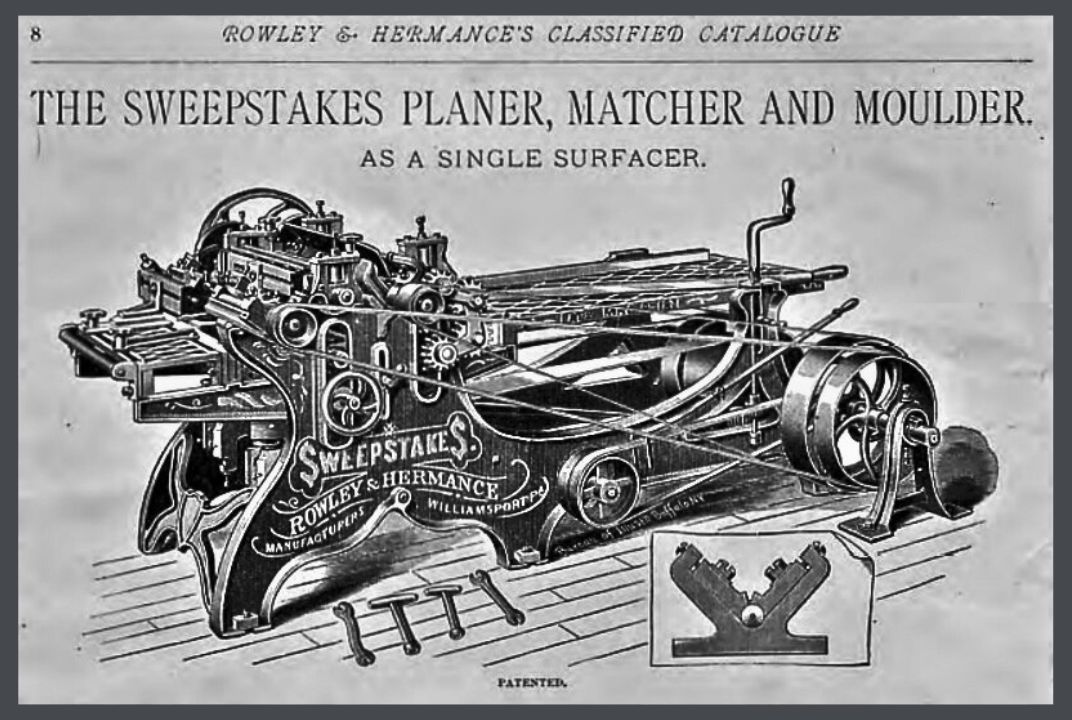
Original catalog page for Sweepstakes planer/matcher.
That same year, I would drive to West Hurley, New York to pick up a Rowley & Hermance “Sweepstakes” planer/matcher. Made in 1884, this machine could do planing, tongue and grooving, or shiplap in one pass. The seller decided he was afraid of it. While going through the mountains to pick up the machine I learned lesson #6: don’t exit the interstate onto a small, steep road with a heavy load.
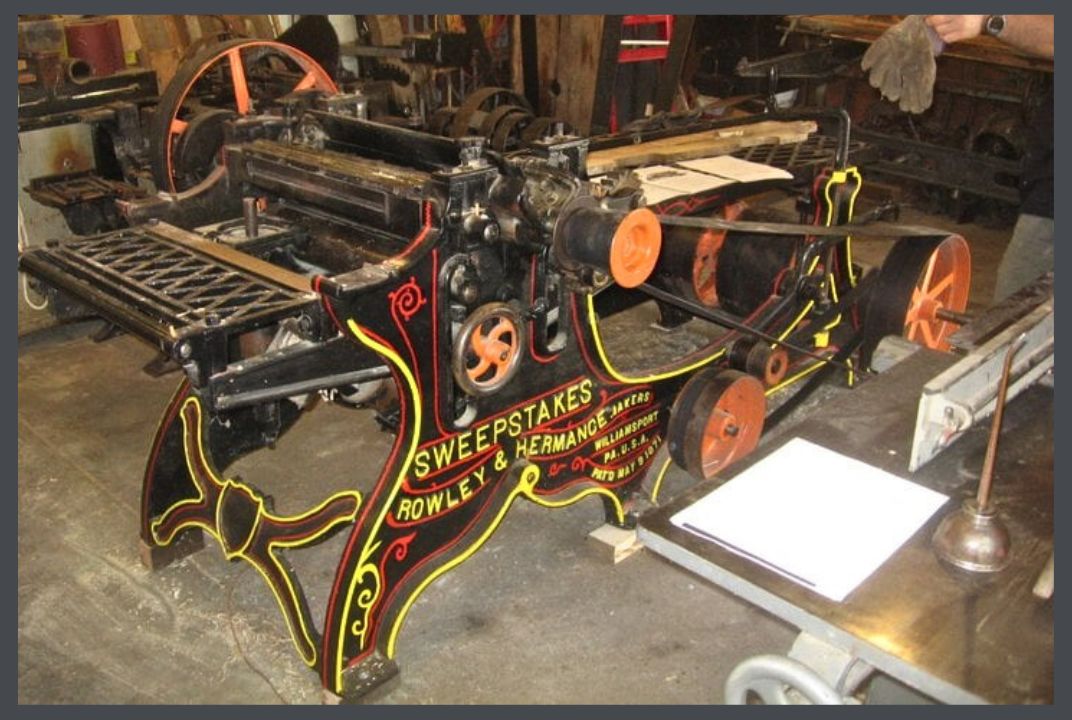
Sweepstakes planer/matcher restored.

The 1880s Lovewell drum sander. It had been there since around the crash of ’29.
While searching online, I saw a large lot of machinery advertised for sale near Peoria, Illinois, in a small town called Canton. The seller wanted a great deal of money for all of it. It was enough machinery to outfit an entire cabinet shop, with nice pictures of machines setting in an old, wood floored building in what looked to be decent condition. I believe the total price was something like $50,000. I made an offer of a few hundred dollars on an interesting 24″ drum sander. The seller said he’d keep that in mind, and I didn’t hear anything more about it…until 2006.
Early in 2006, I got an email from the seller stating that he’d take my offer. I began trying to schedule a pickup date. The seller was a bit evasive on the date of pickup. Even though we had a deal, the seller continued to entertain offers from other people, hoping to get more money. At one point I told him I was coming up there with the money and would either get the sander or go home and not come back. He agreed to meet me there at the shop in April of 2006.
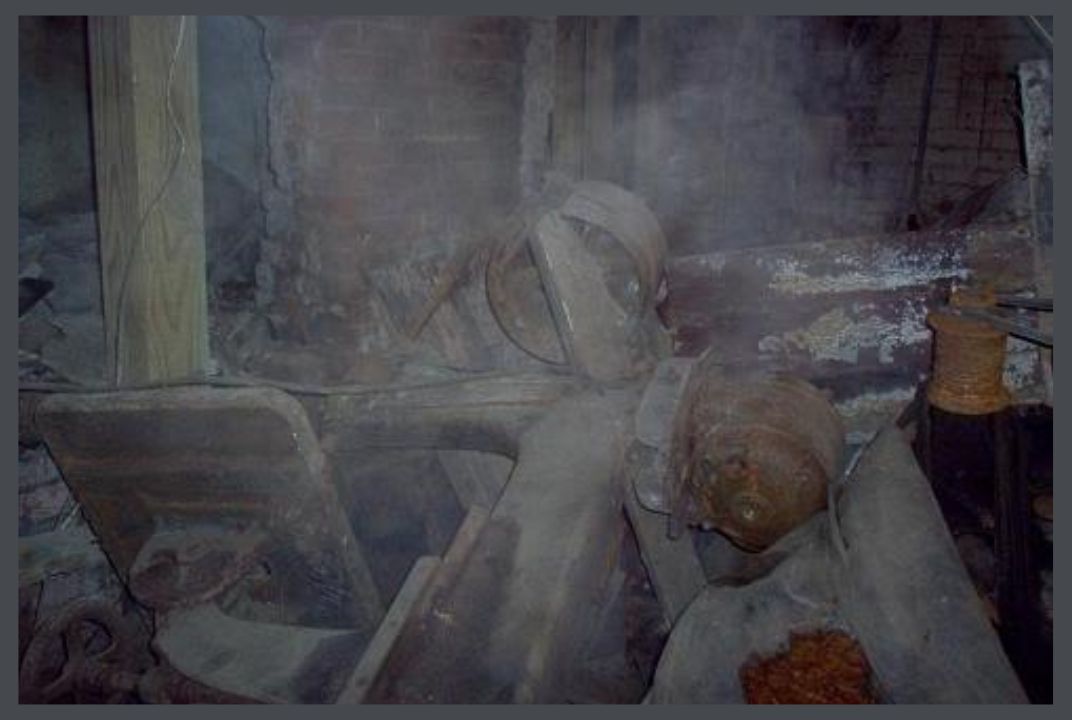
Mist rising from pile of machines fallen through the floor.
Upon our arrival, the front of the building didn’t look too bad. We walked in the front door, and noticed that the floor sloped downward about a foot from the walls to the center. There was a large dark section of NOTHING above us in the center of the building. Someone had propped up a section of sagging second floor with a crooked 4×4. Most of the machines had fallen through the floor into a pile in the basement, but my sander had been stored down there from the start, and was undamaged.

Back stairwell. We definitely weren’t going out that way!
I immediately named the place “Canton Dungeon”. I told my son Conner that if he ever let my shop get like that I’d haunt him. I spent the next 6 hours disassembling the machine and handing the pieces up through an HVAC hole in the floor. It was like working in a cave. It was dark, water was dripping, and mist rose off the piles of rubble. We did get it home safely.
The next few posts will be about the closed mills where we bought machinery. We would buy several at a time, and more than one person would make the trip. Most of these mills were over 100 years old, and provided all the original millwork for the historic houses in their communities.
![]() This article was written by Eric LaVelle, a master restorer of historic houses. He makes the woodwork with a shop full of antique machinery in Belleville, Illinoise. You can visit him on Facebook here.
This article was written by Eric LaVelle, a master restorer of historic houses. He makes the woodwork with a shop full of antique machinery in Belleville, Illinoise. You can visit him on Facebook here.
![]() ERIC LAVELLE, MASTER PRESERVATIONIST, Part 1
ERIC LAVELLE, MASTER PRESERVATIONIST, Part 1
Rescuing old houses.
![]() ERIC LAVELLE, MASTER HISTORIC PRESERVATIONIST, Part 2
ERIC LAVELLE, MASTER HISTORIC PRESERVATIONIST, Part 2
Learning about the old machines.
![]() ERIC LAVELLE, MASTER HISTORIC PRESERVATIONIST, Part 4
ERIC LAVELLE, MASTER HISTORIC PRESERVATIONIST, Part 4
The first trip to the old Lapp mill, built in 1892.
![]() ERIC LAVELLE, MASTER HISTORIC PRESERVATIONIST, Part 5
ERIC LAVELLE, MASTER HISTORIC PRESERVATIONIST, Part 5
Playing “Be Right or Die.” It’s a fun game.
![]() ERIC LAVELLE, MASTER PRESERVATIONIST, Part 6
ERIC LAVELLE, MASTER PRESERVATIONIST, Part 6
Are they lunatics, or are they heroes?
![]() ERIC LAVELLE’S OLD HOUSE MACHINES GLOSSARY
ERIC LAVELLE’S OLD HOUSE MACHINES GLOSSARY
I was clueless about these antique machines he uses & thought that you might be too!
![]() ERIC LAVELLE, Introduction to the Machines
ERIC LAVELLE, Introduction to the Machines
Manufacturing before the Age of Electricity.
![]() ERIC LAVELLE, MASTER HISTORIC PRESERVATIONIST
ERIC LAVELLE, MASTER HISTORIC PRESERVATIONIST
How does he do it?
![]() OLD HOUSE RESTORATION VIDEOS- Eric Lavelle’s Antique Wood-Working Machines
OLD HOUSE RESTORATION VIDEOS- Eric Lavelle’s Antique Wood-Working Machines
Watch the old machines in action. They are loud!!!!

Sign up for our newsletter & receive our FREE E-book, 7 VITAL Things to Do Before You Hire a Contractor.

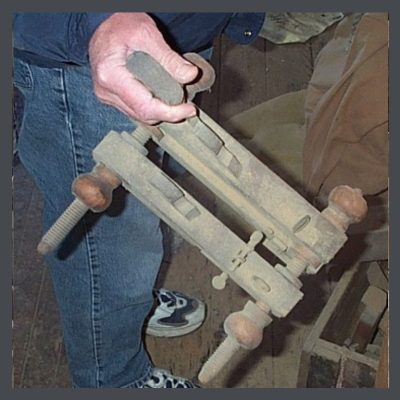 The next in a series of hair-raising tales by Eric LaVelle, who not only restores historic buildings & collects & restores historic tools, but also goes into 100+ year old buildings & braves rotting floors & burnt rafters to collect these ancient machines.
The next in a series of hair-raising tales by Eric LaVelle, who not only restores historic buildings & collects & restores historic tools, but also goes into 100+ year old buildings & braves rotting floors & burnt rafters to collect these ancient machines.
He employs old methods & great ingenuity to remove them from abandoned mills & takes them to his shop where he coaxes them back to life & utility. He has been collecting vintage tools for over a decade & I am privileged (& often horrified) to be able to share his stories.
As with the other sections, the links take you to a GLOSSARY or to videos of the machines which show you how they operate. Some of the videos are of old machines, & some are of modern ones when I couldn’t find ones I like of vintage ones.
This is post #4 in a series of how I got into restoration. This covers more acquisitions for the woodworking shop.
The business that would become Lapp Lumber Mill opened February 14, 1852, in LeRoy, NY. Members of the Lapp family bought and rebuilt the mill after a fire in 1892. It stayed in this family until the last owner/operator, Joseph Lapp, died in 2009. None of the family members wanted to continue it, so the building was sold.
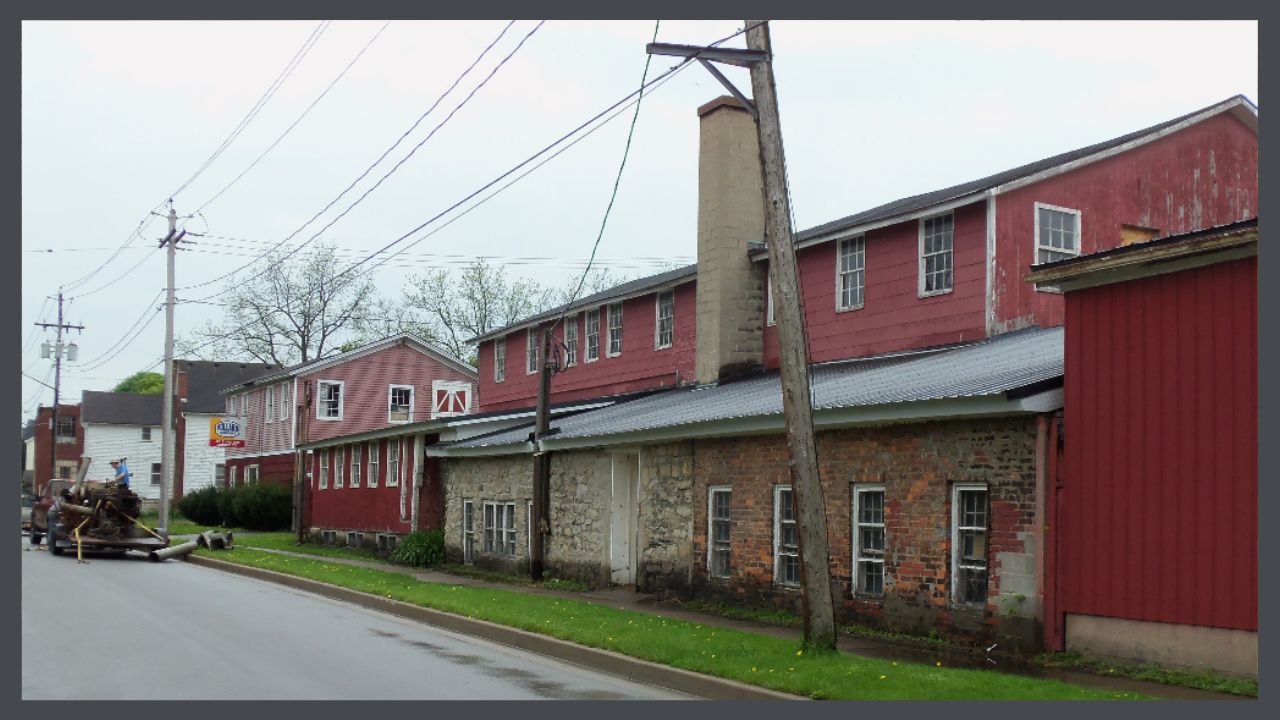
The mill buildings, view from the street.
This mill made windows, doors, shutters, moldings, flooring, siding, and probably some cabinetry. Almost every 19th century house in LeRoy and some surrounding areas has woodwork made in this mill.
A friend and avid machine collector/user, Bill, decided to help Joseph’s wife sell the contents of the building. He contacted me very early, because the machines were from the era I was buying, and I had watched stuff sell for a number of years and was familiar with values. I helped put a price on it that was reasonable enough that it would all sell. I’ve included some of Bill’s initial photos.
The mill was a time capsule. It was still operating via large lineshafts, which were first powered by either water or steam, then certainly by steam, and then by a couple huge electric motors. I made a deal to buy a two piece lineshaft driven scroll saw and a 36″ circular resaw. These two machines were very hard to find.

L. The 1890’s J.S. Graham 36″ circular resaw. R. The L.S. Colburn scroll saw set up in my basement shop.

The 1880s Jos. O. Colladay tenoner in my basement shop.
Another friend, Dan, bought at least one machine, a tenoner, which was on the second floor. I would eventually buy this tenoner from Dan, but at that time we agreed to meet there and help each other with rigging.
Part of the second floor had been in a fire. The floor was a little shaky, and there were charred rafters above it that had been sistered. We decided we needed to take the machine out the other end of the building. There was a forklift on site.
After helping Dan move the tenoner toward the exit, I went down to start rigging my stuff out. It went mostly without incident, but there’s always something annoying that gets in the way. My personal favorite was the loose board in the dubious floor on the way out with the resaw. It was like one of those cartoon scenes where you step on one end and the other flies up and hits you in the head. Even more fun while pulling on a huge saw.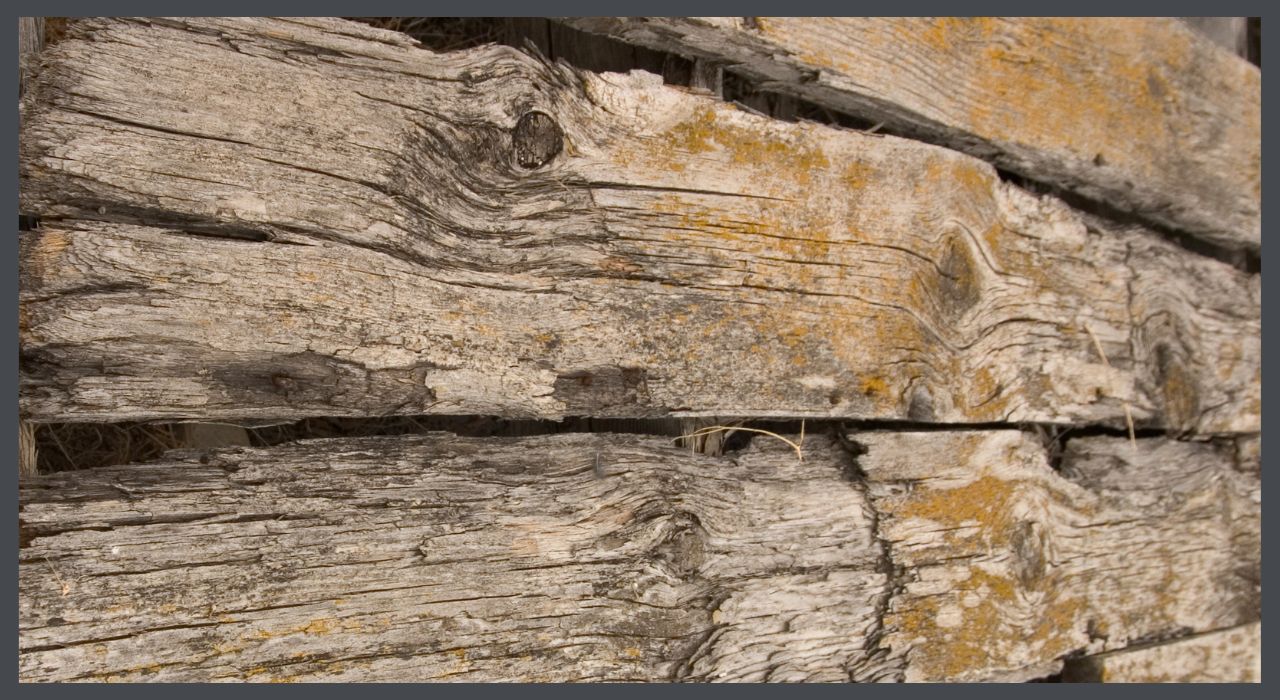
Dan and I got our machines safely loaded and hauled home.

![]() This article was written by Eric LaVelle, a master restorer of historic houses. He makes the woodwork with a shop full of antique machinery in Belleville, Illinoise. You can visit him on Facebook here.
This article was written by Eric LaVelle, a master restorer of historic houses. He makes the woodwork with a shop full of antique machinery in Belleville, Illinoise. You can visit him on Facebook here.
![]() ERIC LAVELLE, MASTER PRESERVATIONIST, Part 1
ERIC LAVELLE, MASTER PRESERVATIONIST, Part 1
Rescuing old houses.
![]() ERIC LAVELLE, MASTER HISTORIC PRESERVATIONIST, Part 2
ERIC LAVELLE, MASTER HISTORIC PRESERVATIONIST, Part 2
Learning about the old machines.
![]() ERIC LAVELLE, MASTER HISTORIC PRESERVATIONIST, Part 3
ERIC LAVELLE, MASTER HISTORIC PRESERVATIONIST, Part 3
More lessons, learned the hard way!
![]() ERIC LAVELLE, MASTER HISTORIC PRESERVATIONIST, Part 5
ERIC LAVELLE, MASTER HISTORIC PRESERVATIONIST, Part 5
Playing “Be Right or Die.” It’s a fun game.
![]() ERIC LAVELLE, MASTER PRESERVATIONIST, Part 6
ERIC LAVELLE, MASTER PRESERVATIONIST, Part 6
Are they lunatics, or are they heroes?
![]() ERIC LAVELLE’S OLD HOUSE MACHINES GLOSSARY
ERIC LAVELLE’S OLD HOUSE MACHINES GLOSSARY
I was clueless about these antique machines he uses & thought that you might be too!
![]() ERIC LAVELLE, Introduction to the Machines
ERIC LAVELLE, Introduction to the Machines
Manufacturing before the Age of Electricity.
![]() ERIC LAVELLE, MASTER HISTORIC PRESERVATIONIST
ERIC LAVELLE, MASTER HISTORIC PRESERVATIONIST
How does he do it?
![]() OLD HOUSE RESTORATION VIDEOS- Eric Lavelle’s Antique Wood-Working Machines
OLD HOUSE RESTORATION VIDEOS- Eric Lavelle’s Antique Wood-Working Machines
Watch the old machines in action. They are loud!!!!

Sign up for our newsletter & receive our FREE E-book, 7 VITAL Things to Do Before You Hire a Contractor.
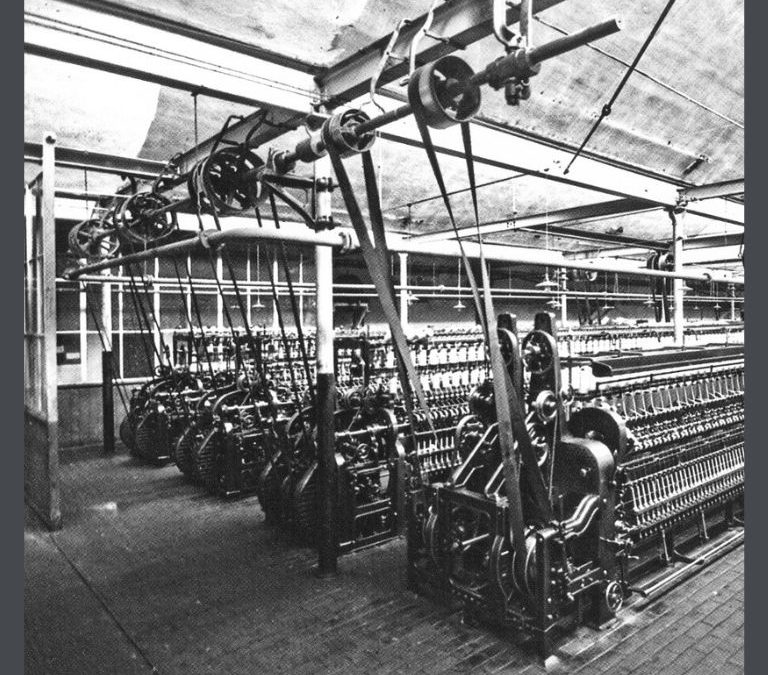
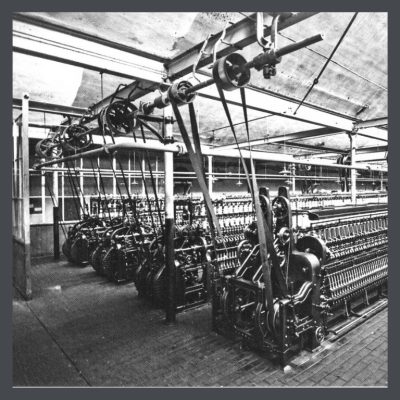 To understand the challenges of removing the machines mentioned in this article, you need to read about line shafts. They are monster pieces of equipment that back in the day, cost people their fingers, their hearing & probably some lives.
To understand the challenges of removing the machines mentioned in this article, you need to read about line shafts. They are monster pieces of equipment that back in the day, cost people their fingers, their hearing & probably some lives.
Because of the rickety mill floors & the expense of power equipment, like forklifts, to remove these machines, they were moved with a combination of wits, skill, passion & luck, through the use of artfully placed hand equipment. You can read about this equipment in the article here.
If you are not shocked & amazed by what you see, read it again. There’s something that you didn’t get!
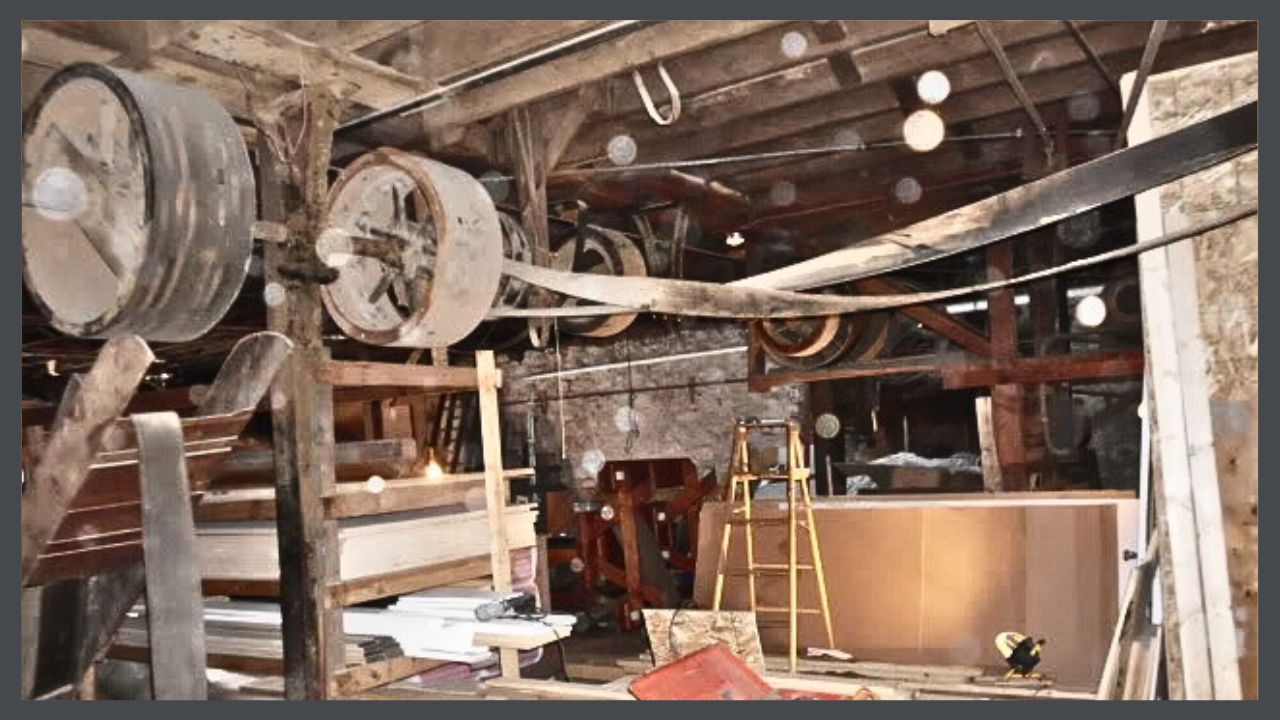
The 33ft line shaft. There was also a 20ft line shaft.
I would make a second trip to buy one of the line shaft motors, a 15HP low RPM Westinghouse, from sometime around 1910. I looked at the enormous line shaft, one section 2 7/16″ shaft diameter 20ft long, and the other one 33ft long, and said “I’m glad I don’t have to take that down.” Of course I ended up having to take it down!
It took me over a year to decide to buy the heavy molder, blower, lineshaft drive motors, and all of the lineshaft from Lapp Mill. It was a great deal, but it was at my budget limit, and it was a logistical nightmare. It was 800 miles away from my shop.

The molder.
In November 2010, I went ahead and made the decision to purchase the stuff at Lapp Mill. At the same time, Jim made his purchases, and we decided to go together. I sweet talked Dan into agreeing to haul the heavy molder to Indiana for me at about that time as well. Since we’ve all had a great deal of trouble with winter hauls, we decided to wait until spring for the pickup.
Jim, Bill, and I arrived at Lapp Mill on the morning of Thursday, May 12th. Jim and I had figured out a way to bring down the line shaft with 3 chain hoists and some short lengths of 1/4″ welded link chain. It was rated so that any single chain could support 1200lbs just in case a whole line shaft ended up hanging from one chain. I told Jim, “We’re about to play Be Right or Die, and we’d better be right.”
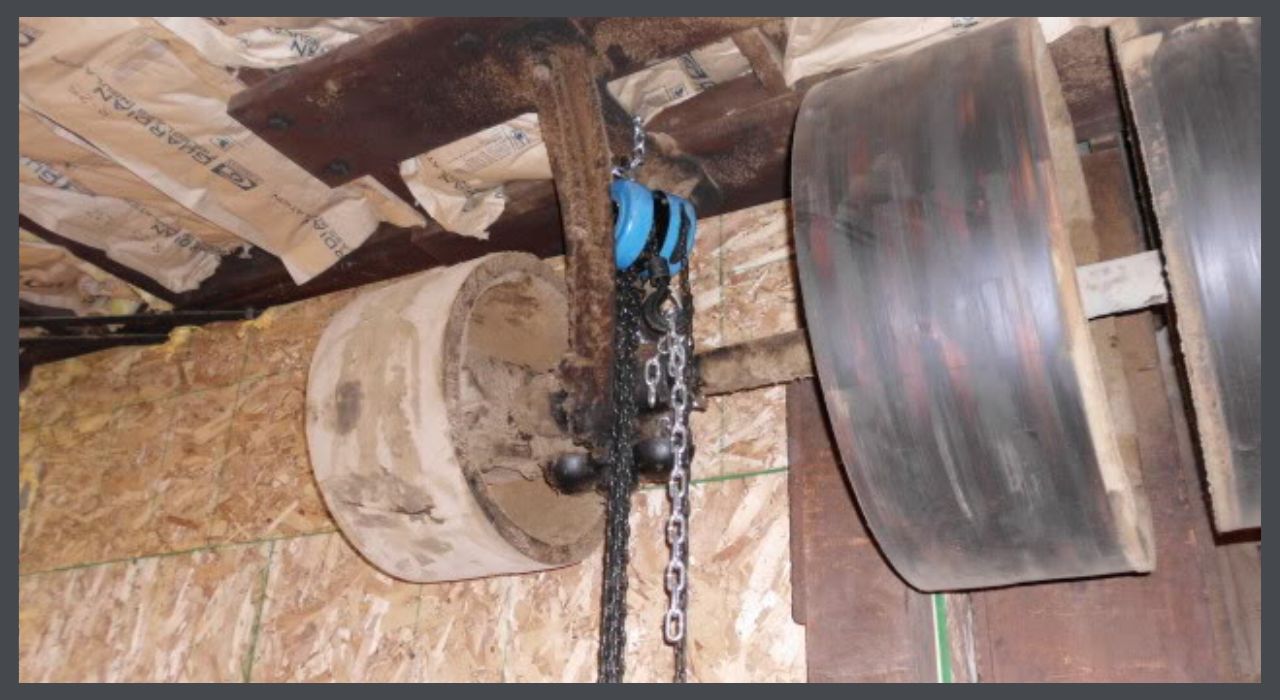
Chain hoist supporting the line shaft to lower it. We used 3 of these at the same time.
The line shafts and counter shafts had a total of something like 29 pulleys ranging from over 8″ in diameter to perhaps 30.” We used one chain hoist at each line shaft hanger, looping a 3′ section of chain through the base of the hanger, and another 3′ section of chain around the shafting itself. This kept the shaft from dropping on one end or another. We put upward pressure on the shaft with the hoists, and unbolted the ends of the hangers. We then lowered the shaft out of the hangers and onto saw horses so we could remove the pulleys. Bill took the pulleys off and labeled each one. It took 3 of us to carry a 20ft long piece of the shaft to the trailer. The steel shaft alone weighed 320lbs.
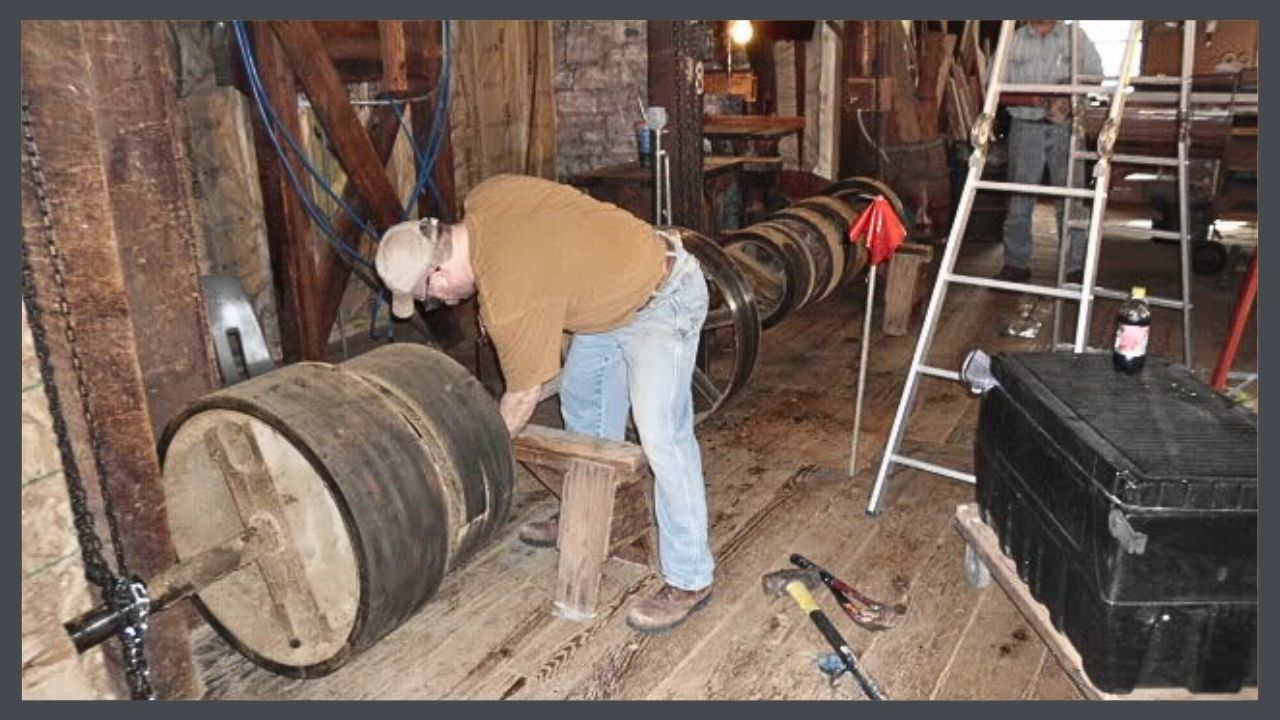
20 ft line shaft lowered onto sawhorses. The 33 ft one was even longer & way more cumbersome. And heavy!
It was late in the day, Jim and I were tired, and this last counter shaft had hangers that didn’t have tops that could be removed to lower the shaft. The whole thing had to be unbolted from the ceiling, and lowered hangers and all. The only thing we could use as a lift point (the place where I attached the pulley or hoist to lift or lower something.) In that case, we hung the pulley from a small loop of chain around the 1″ electrical conduit.
First, the line we tied to it was too slack, which would cause it to free fall about 8″ before the line supported it. We left one end of it on the top of that door and Jim unbolted that end first. He began unbolting the other end while on the ladder in front of it. I thought that looked dangerous, and I asked him to unbolt it with his ladder past the end, just in case. I wrapped the end of the support rope around my left wrist on the outside of my glove.
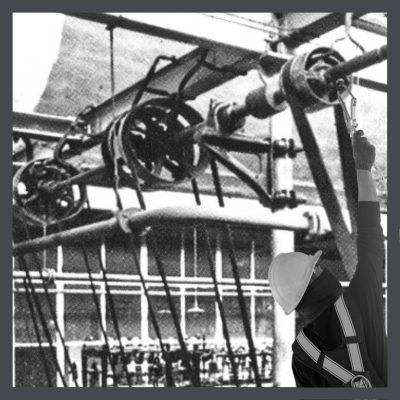 As soon as Jim took the last bolt out of the hanger, the counter shaft dropped on his end, the hanger slid off, forcing him to catch it while on the ladder. Seconds later, the other end rolled off the top of that door, that end dropped, spit the hanger off onto the floor, and pulled my left hand into the air, leaving me half hanging there like some kind of giant, dirt coated Christmas ornament. I couldn’t reach the counter shaft with my left hand to lift it and release my right hand, so I said “Uhh…Jim, I need some help here…” as he came down the ladder with the hanger in his hands while being blinded by the halogen lamp shining in his face. When he got down, he pulled down on the rope and released me.
As soon as Jim took the last bolt out of the hanger, the counter shaft dropped on his end, the hanger slid off, forcing him to catch it while on the ladder. Seconds later, the other end rolled off the top of that door, that end dropped, spit the hanger off onto the floor, and pulled my left hand into the air, leaving me half hanging there like some kind of giant, dirt coated Christmas ornament. I couldn’t reach the counter shaft with my left hand to lift it and release my right hand, so I said “Uhh…Jim, I need some help here…” as he came down the ladder with the hanger in his hands while being blinded by the halogen lamp shining in his face. When he got down, he pulled down on the rope and released me.
Just another day collecting antique machinery.
![]() ERIC LAVELLE, MASTER PRESERVATIONIST, Part 1
ERIC LAVELLE, MASTER PRESERVATIONIST, Part 1
Rescuing old houses.
![]() ERIC LAVELLE, MASTER HISTORIC PRESERVATIONIST, Part 2
ERIC LAVELLE, MASTER HISTORIC PRESERVATIONIST, Part 2
Learning about the old machines.
![]() ERIC LAVELLE, MASTER HISTORIC PRESERVATIONIST, Part 3
ERIC LAVELLE, MASTER HISTORIC PRESERVATIONIST, Part 3
More lessons, learned the hard way!
![]() ERIC LAVELLE, MASTER HISTORIC PRESERVATIONIST, Part 4
ERIC LAVELLE, MASTER HISTORIC PRESERVATIONIST, Part 4
The first trip to the old Lapp mill, built in 1892.
![]() ERIC LAVELLE, MASTER PRESERVATIONIST, Part 6
ERIC LAVELLE, MASTER PRESERVATIONIST, Part 6
Are they lunatics, or are they heroes?
![]() ERIC LAVELLE’S OLD HOUSE MACHINES GLOSSARY
ERIC LAVELLE’S OLD HOUSE MACHINES GLOSSARY
I was clueless about these antique machines he uses & thought that you might be too!
![]() ERIC LAVELLE, Introduction to the Machines
ERIC LAVELLE, Introduction to the Machines
Manufacturing before the Age of Electricity.
![]() ERIC LAVELLE, MASTER HISTORIC PRESERVATIONIST
ERIC LAVELLE, MASTER HISTORIC PRESERVATIONIST
How does he do it?
![]() OLD HOUSE RESTORATION VIDEOS- Eric Lavelle’s Antique Wood-Working Machines
OLD HOUSE RESTORATION VIDEOS- Eric Lavelle’s Antique Wood-Working Machines
Watch the old machines in action. They are loud!!!!
![]() This article was written by Eric LaVelle, a master restorer of historic houses. He makes the woodwork with a shop full of antique machinery in Belleville, Illinoise. Visit him on Facebook here.
This article was written by Eric LaVelle, a master restorer of historic houses. He makes the woodwork with a shop full of antique machinery in Belleville, Illinoise. Visit him on Facebook here.
TIP: Eric’s hair-raising tales express his passion for the antique machinery he rescues from old mills. You can start here!

Sign up for our newsletter & receive our FREE E-book, 7 VITAL Things to Do Before You Hire a Contractor.


Old sinks I found in the Alligator Pit.
This is another thrilling episode of Eric LaVelle’s gallant rescues of old woodworking machines from crumbling buildings.
The links take you to a GLOSSARY or to a page of videos of the old machines in action. Take advantage!
It was nearly time to leave the Old Lapp Mill, and I wanted to see the sawdust pit/basement, which Priscilla called the “Alligator pit”.
When her children were young, her husband told them there were alligators down there, and he’d put them down there if they didn’t behave.
In a corner with the least amount of piled up sawdust, I saw a corner sink. I decided to dig and see if there was another one. With a couple scoops, I uncovered yet another sink, this one white marble with a porcelain bowl, and a marble backsplash for it.
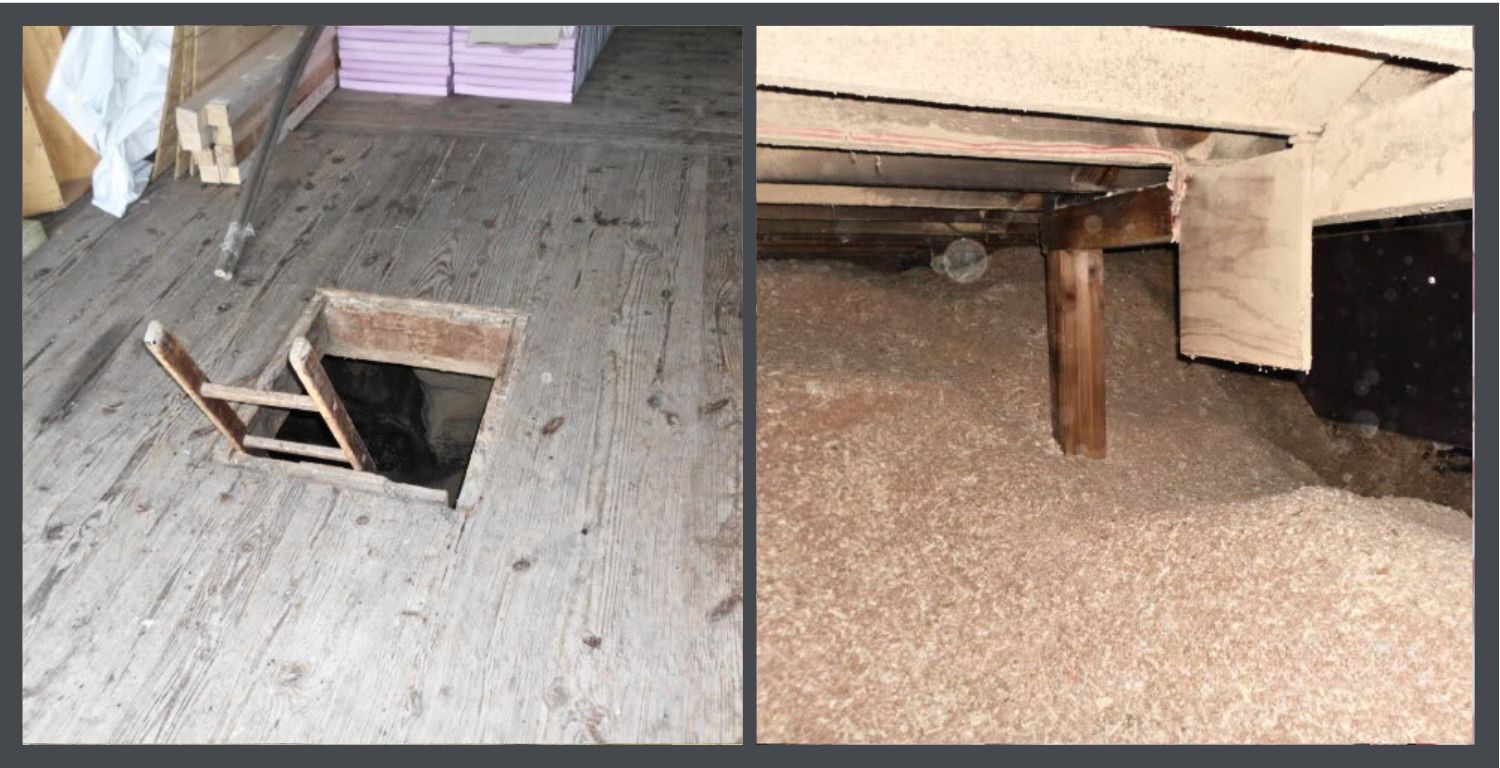
The “Alligator Pit.”
[Sawdust is not just highly flammable but can actually explode into flames. After 45 years as a Safety Officer for a wood flooring company, the sight of all this sawdust made my hair stand on end. I have seen someone with terrible scars all over their body from just a small amount of sawdust exploding in a sander bag. The Lapp Mill burned once in the late 1800’s. I guess that they forgot.]
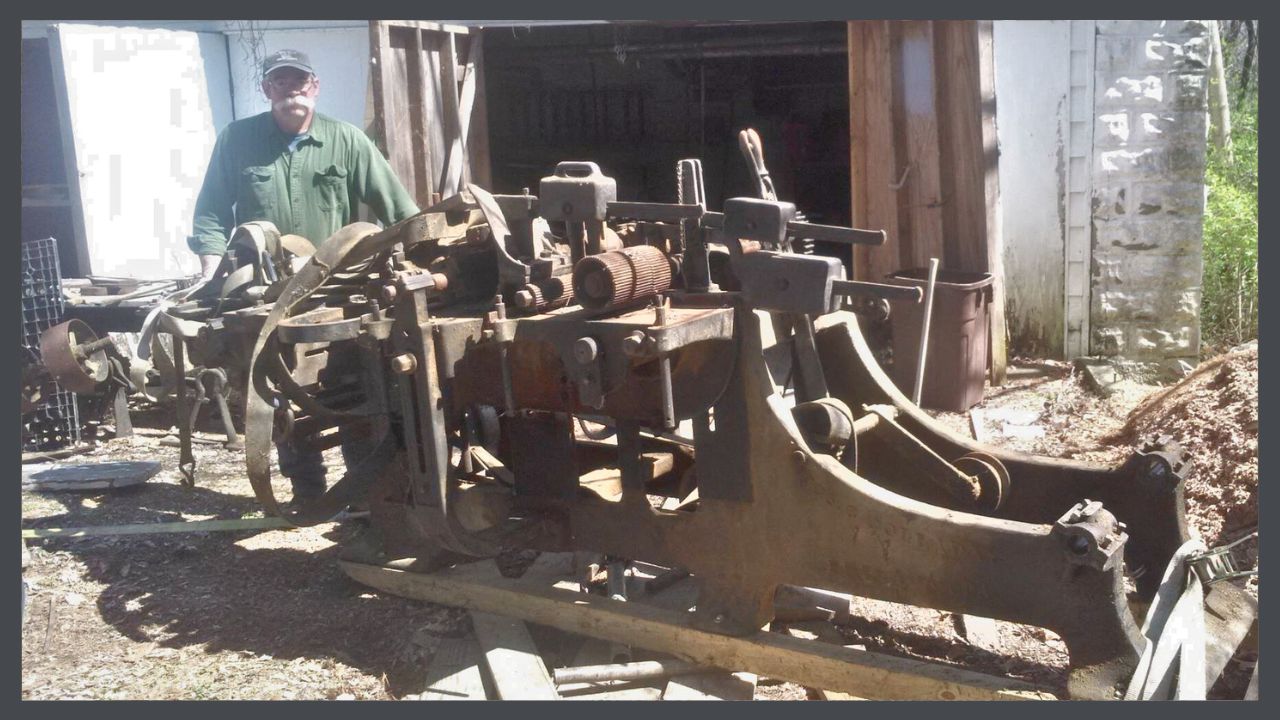
Colladay sticker molder.
Finally, we had to move the heavy Colladay sticker/molder 11 1/2′ long, 4 1/2′ wide weighing 4000-5000lbs (we think). I named it The Lapp Ness Monster. I think that story was best told by one of the others there, Rick Bruner:
“Now being the inexperienced guy I am, I looked at the molder and thought too bad they can’t get this out of here. Then I realized that was what they were planning on doing. I took a look at the 60 to 70 feet they had to move this through the mill (and not a straight run at that), I looked at the rickety floor boards of which none were tight or level, I looked at the slight but inclined path they had to follow and said to myself – get in your truck and get out of town before the rubber room custodians come and take these guys back.
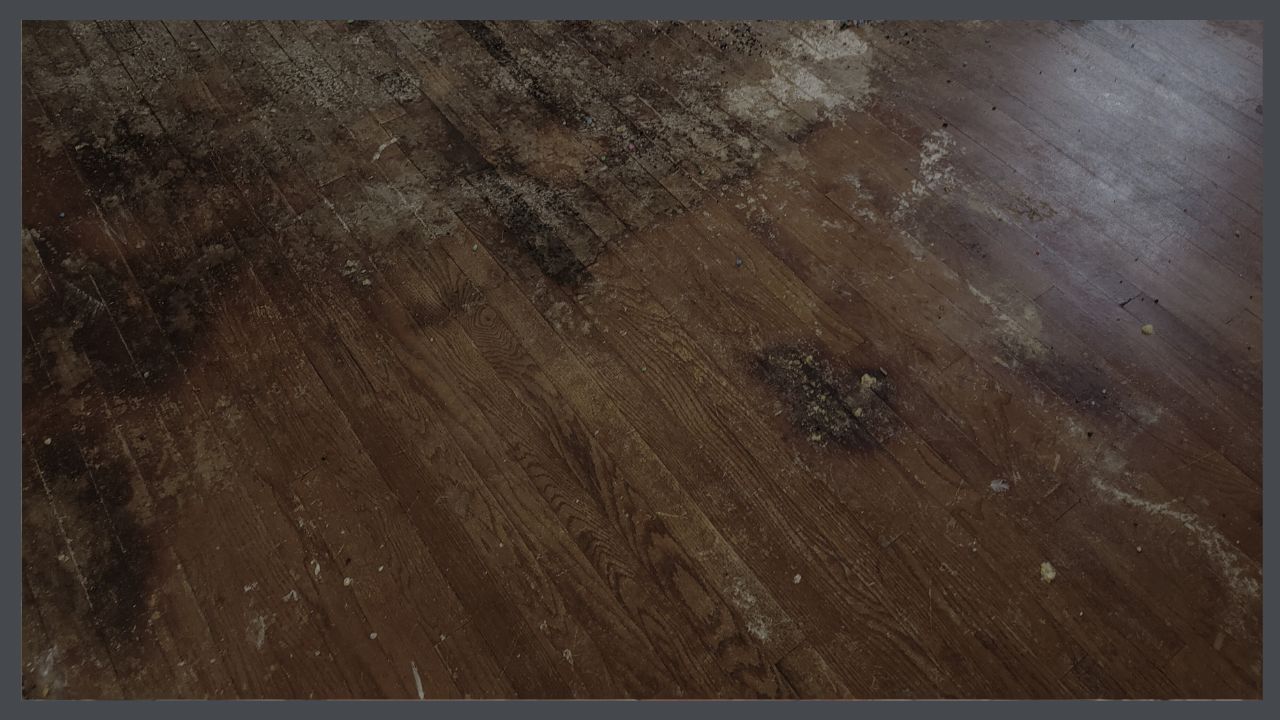
Rotten, uneven, ancient floors. Scary!
“You see, in my mind, they were either raving lunatics or super heroes and at that point I was strongly leading towards lunatics.
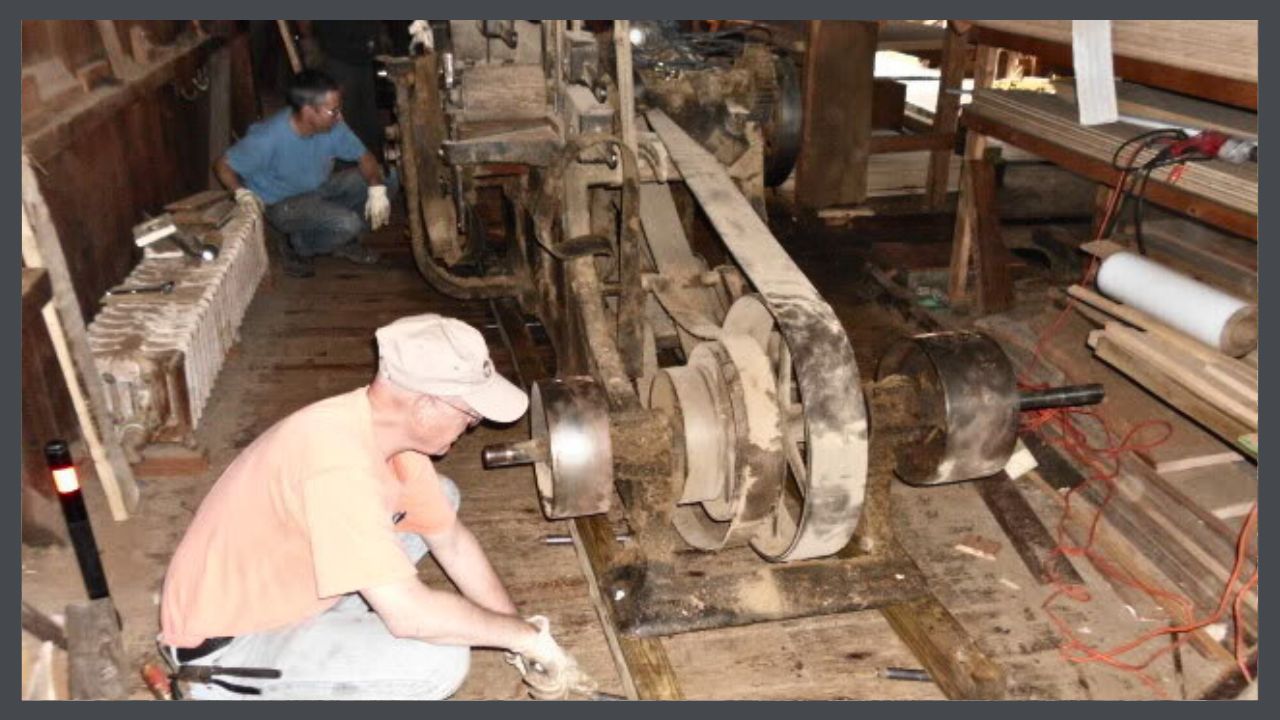
Here the molder is bolted to 4×6 timbers, and pipes are being set under it at an angle to steer it.
“Eric rolls in a little floor jack (I’m thinking what does he imagine he is going to do with that). Well he jacks up the molder and out come a dozen or so 12″ pieces of 1″ pipe and guys are scurrying around placing the pipe under the skids previously bolted to the molder. I again resist the tendency to get out of town because of the human nature aspect of watching a train wreck (you know what I mean). I did try to make sure I was standing in a spot that was reasonably safe when the floor collapsed like I was sure it would.
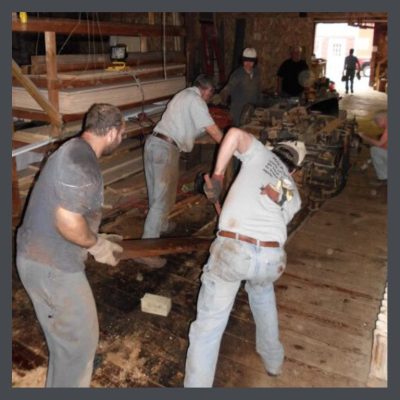 “So all the pipe gets placed and out comes a 2 X 8 and these guys start levering the 2 X 8 and lo and behold the mammoth molder starts to slowly move – inches at a time. Using the pipe at various angles they were actually able to ‘steer’ the molder fairly successfully. In what seemed like no time the molder was at the door and Dan was backing his trailer up. A few supports to adjust for height and the use of a come along resulted in the molder easily going onto Dan’s trailer.”
“So all the pipe gets placed and out comes a 2 X 8 and these guys start levering the 2 X 8 and lo and behold the mammoth molder starts to slowly move – inches at a time. Using the pipe at various angles they were actually able to ‘steer’ the molder fairly successfully. In what seemed like no time the molder was at the door and Dan was backing his trailer up. A few supports to adjust for height and the use of a come along resulted in the molder easily going onto Dan’s trailer.”
All of this took 3 very long days. The amount of physical labor we did was just brutal. I’m used to a fair amount of it, and Jim is used to even more, but we hurt more every day, and the degree of fatigue made it harder to think as well. At one point Jim said, “I feel worse than when I got hit by a car.”

The Lapp Mill, 1892
Alas, Lapp Mill is no more. It was later demolished. I believe it could have been an incredible museum if any preservation minded people would have saved it. I ultimately ended up with 6 machines from the mill.
![]() This article was written by Eric LaVelle, a master restorer of historic houses. He makes the woodwork with a shop full of antique machinery in Belleville, Illinoise. Visit him on Facebook here.
This article was written by Eric LaVelle, a master restorer of historic houses. He makes the woodwork with a shop full of antique machinery in Belleville, Illinoise. Visit him on Facebook here.
![]() ERIC LAVELLE, MASTER PRESERVATIONIST, Part 1
ERIC LAVELLE, MASTER PRESERVATIONIST, Part 1
Rescuing old houses.
![]() ERIC LAVELLE, MASTER HISTORIC PRESERVATIONIST, Part 2
ERIC LAVELLE, MASTER HISTORIC PRESERVATIONIST, Part 2
Learning about the old machines.
![]() ERIC LAVELLE, MASTER HISTORIC PRESERVATIONIST, Part 3
ERIC LAVELLE, MASTER HISTORIC PRESERVATIONIST, Part 3
More lessons, learned the hard way!
![]() ERIC LAVELLE, MASTER HISTORIC PRESERVATIONIST, Part 4
ERIC LAVELLE, MASTER HISTORIC PRESERVATIONIST, Part 4
The first trip to the old Lapp mill, built in 1892.
![]() ERIC LAVELLE, MASTER HISTORIC PRESERVATIONIST, Part 5
ERIC LAVELLE, MASTER HISTORIC PRESERVATIONIST, Part 5
Playing “Be Right or Die.” It’s a fun game.
![]() ERIC LAVELLE’S OLD HOUSE MACHINES GLOSSARY
ERIC LAVELLE’S OLD HOUSE MACHINES GLOSSARY
I was clueless about these antique machines he uses & thought that you might be too!
![]() ERIC LAVELLE, Introduction to the Machines
ERIC LAVELLE, Introduction to the Machines
Manufacturing before the Age of Electricity.
![]() ERIC LAVELLE, MASTER HISTORIC PRESERVATIONIST
ERIC LAVELLE, MASTER HISTORIC PRESERVATIONIST
How does he do it?
![]() OLD HOUSE RESTORATION VIDEOS- Eric Lavelle’s Antique Wood-Working Machines
OLD HOUSE RESTORATION VIDEOS- Eric Lavelle’s Antique Wood-Working Machines
Watch the old machines in action. They are loud!!!!

Sign up for our newsletter & receive our FREE E-book, 7 VITAL Things to Do Before You Hire a Contractor.

 As muses & artisans of the Arts & Crafts Movement, women inspired & changed the course of history through their works, both in the early years in England & later here in America.
As muses & artisans of the Arts & Crafts Movement, women inspired & changed the course of history through their works, both in the early years in England & later here in America.
Had there been no Industrial Revolution, the Movement quite likely would never have formed. Had women had equal rights, this would have been reflected- & we might consider May to be originator of the movement, rather than just William’s daughter, only recently receiving the wide recognition so richly deserved.
Art exerts profound influence on culture & conversely, throughout history, conditions of the day have always provided creative individuals with material to motivate works that support or protest.
I turn to the scholars in the videos below to relay to you the wonderful stories of these women. I love learning from these sources & hope that you will too.
If you’d like to know more about the Arts & Crafts Movement, & what it might have to do with your bungalow, click here.
In this video you will see some beautiful jewelry pieces as well as getting an overview of the subject of women as muse & the male response to women becoming more bold.
The images show up a few minutes in. They are worth the wait!
TIP: To learn more about the Arts & Crafts Movement, watch all my videos, HERE!

Sign up for our newsletter & receive our FREE E-book, 7 VITAL Things to Do Before You Hire a Contractor.
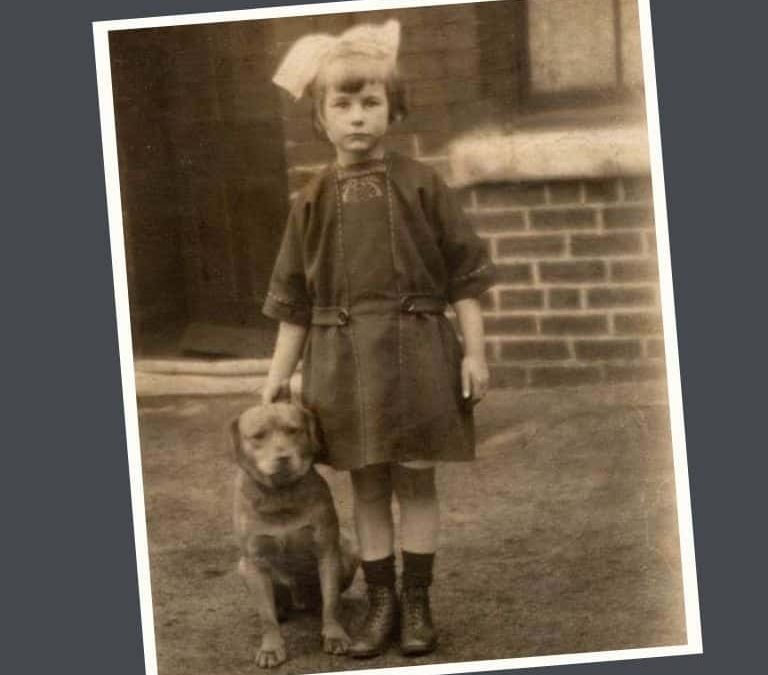
by Barbara Farrar (October 6, 1926 – March 29, 2011)
 As I recall the years of my childhood spent in “Tampa Town,” I am always cognizant of the changes that have accompanied our metamorphosis into a much larger city. One of them has impacted the daily lives of today’s neighborhood children. It has to do with pets and the different role they presently play. In those days, we all had pets, but they were not like the pampered, purebred or exotic ones prized by children today. They were “adopted” stray dogs and cats (Heinz 57 variety), plus many other varied forms of wildlife….and I do mean wild.
As I recall the years of my childhood spent in “Tampa Town,” I am always cognizant of the changes that have accompanied our metamorphosis into a much larger city. One of them has impacted the daily lives of today’s neighborhood children. It has to do with pets and the different role they presently play. In those days, we all had pets, but they were not like the pampered, purebred or exotic ones prized by children today. They were “adopted” stray dogs and cats (Heinz 57 variety), plus many other varied forms of wildlife….and I do mean wild.
You see, Seminole Heights was not thickly populated, and was surrounded by acres of undeveloped woods. The Hillsborough River was a source of water and habitat for the native animals which frequented our bungalow neighborhood, and to which we children were hypnotically drawn. Likewise, they seemed to trust us, and we openly, or surreptitiously, fed them. Occasionally, these wild visitors were injured or just seemed sickly, so we established a “hospital” where we took turns caring for them. This was usually in one of our garages. Baby birds, squirrels, bunnies, possum and raccoons were frequent patients. We also cared for field mice, injured water birds, bats and songbirds. We raided our families’ medicine chests for various ointments, antiseptics and bandages. Produce boxes that came with ventilation holes made great cages. Chicken feed, cat and dog food and milk were the usual infirmary diet that kept them alive. However, I must admit that the survival rate was not very high. But, you can be assured that each deceased patient was given a full funeral from casket burial to flowers and a headstone in a nearby “pet cemetery”.
Pet care was, totally, the child’s responsibility. Any failure to assume this responsibility resulted in strict discipline and/or removal of the pet. Responsibility was developed at an early age.
No pets, domestic or wild, were ever allowed in the house or the car. Canaries, parrots and goldfish were the only indoor pets. Bad storms and freezing weather were the only exceptions to the house rule. Dogs and cats were fed canned pet food and table scraps. They were allowed to eat in the kitchen before being sent outside. Fresh drinking water was always available both inside and out. Dog and cat diets were supplemented by our trips to the local butcher shop. The owner, who was a neighbor, saved meat scraps and bones for the dogs and beef liver pieces for the cats.
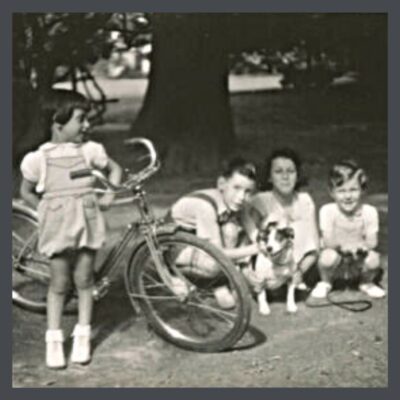 Oddly enough, our cats and dogs were rarely ill. There were very few vets in the area, except for those who treated livestock. Once a year, our dogs got a rabies shot and tags to wear as well as an “annual worming.” The dogcatcher was quick to impound a tagless dog. There was no need to “walk the dog”. Wherever we children went, our four-footed friends trotted with us. We played so closely with them, that they seemed almost like siblings. They really enjoyed pacing us on our bicycles, the faster the better. Playing “hide and seek” was a favorite activity which they always won. The real challenge came during baseball games when the outfielder often had to out run the dogs for the ball. In retrospect, our dogs were tolerant and long-suffering. They endured many bumpy rides in our wagons, while dressed in some pretty weird outfits that only a child could create.
Oddly enough, our cats and dogs were rarely ill. There were very few vets in the area, except for those who treated livestock. Once a year, our dogs got a rabies shot and tags to wear as well as an “annual worming.” The dogcatcher was quick to impound a tagless dog. There was no need to “walk the dog”. Wherever we children went, our four-footed friends trotted with us. We played so closely with them, that they seemed almost like siblings. They really enjoyed pacing us on our bicycles, the faster the better. Playing “hide and seek” was a favorite activity which they always won. The real challenge came during baseball games when the outfielder often had to out run the dogs for the ball. In retrospect, our dogs were tolerant and long-suffering. They endured many bumpy rides in our wagons, while dressed in some pretty weird outfits that only a child could create.
A special neighborhood pet was the green chameleon. We all had one which we confined with a collar of silk thread and wore on our shoulders. What we didn’t understand at the time was why it occasionally inflated that bright, red bubble under its throat. Eventually, we learned it was done to frighten enemies. The poor thing was terrified! We just thought it was pretty!
Today, I see only adult dog walkers pass my home. The majority wear headsets, and show impatience with the animal’s frequent “scent stops”. I often think of the sheer joy and wild abandon that neighborhood children shared in play with their pets. Tampa Town was truly a kinder, gentler place in which to experience reciprocal affection with one’s pet. Its disappearance is a tremendous loss.
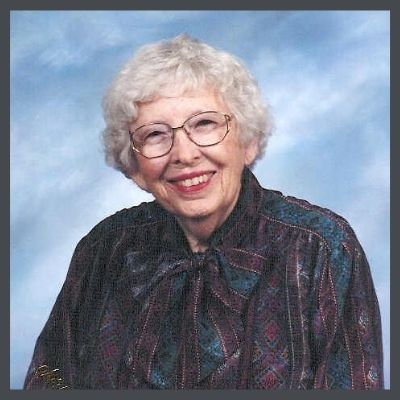 I had the great honor & extreme pleasure, of meeting Barbara when I interviewed her for the documentary film, Seminole Heights, An Intimate Look at the Early Years, that I produced about the neighborhood. In her 80’s, she was warm, bright, perceptive, articulate, & possessed a whimsical sense of humor. I have to say that she was the star of the show.
I had the great honor & extreme pleasure, of meeting Barbara when I interviewed her for the documentary film, Seminole Heights, An Intimate Look at the Early Years, that I produced about the neighborhood. In her 80’s, she was warm, bright, perceptive, articulate, & possessed a whimsical sense of humor. I have to say that she was the star of the show.
Barbara had spent her whole life in the Seminole Heights, attended our neighborhood schools graduating from Hillsborough High School in 1946, & in 1990, she was inducted into their Hall of Fame.
Barbara graduated in the first class of the newly established Florida State University in 1948 with a degree in journalism, & continued her education to get a Master’s Degree in Social Work. She went on to work for 41 years as a social worker.
In addition to being the champion for hundreds of children & families, Barbara worked as a volunteer for many organizations, focusing on our neighborhood. Serving as Editor of the Old Seminole Heights Neighborhood Association newsletter, The Advisor, Barbara strove to build a sense of community & respect for our history.
In addition to being featured in the documentary, you can see more of her story in the print version of the article in American Bungalow on the neighborhood.
 STAY IN THE BUNGALOW KNOW!!!
STAY IN THE BUNGALOW KNOW!!!Sign up for our newsletter & receive our FREE E-book, 7 VITAL Things to Do Before You Hire a Contractor.